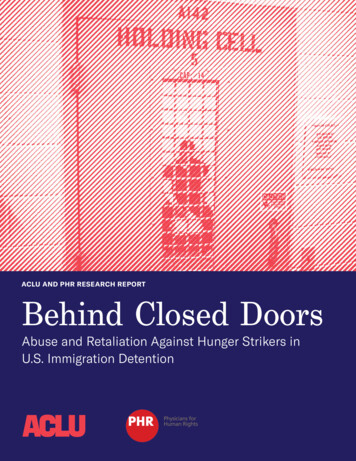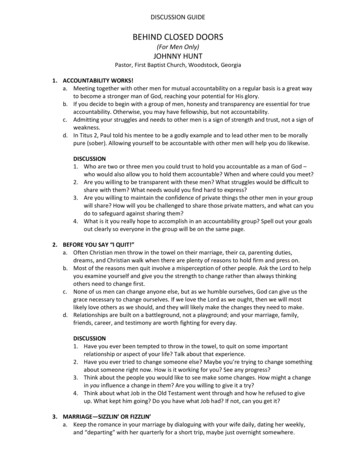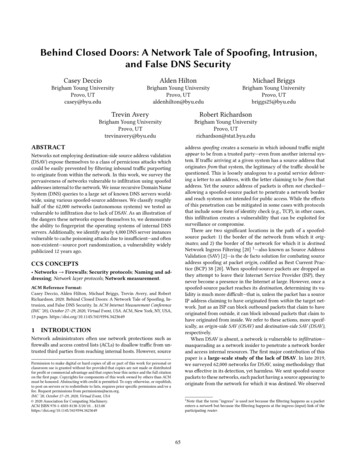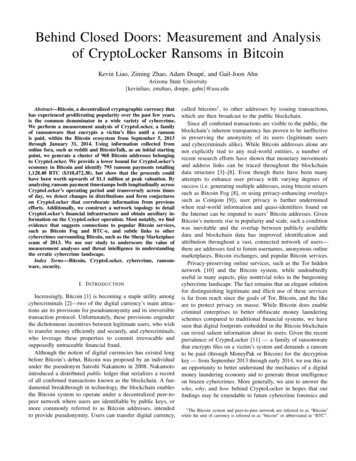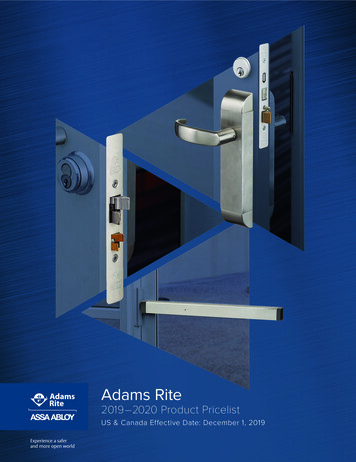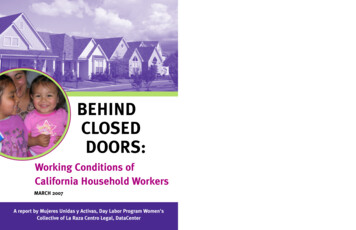
Transcription
behind closed doorsby W.P. MalcomsonThis electronic version of the 1999 paperback bookmaintains the pagination of the original for the purposesof consistency and ease of reference. A copyrightstatement relating to this version is given on page 4.1
ISBN 0 9535873 0 42
behind closed doorsthe hidden structure within the Orange camp[ the Royal Arch Purple Order]examined from an evangelical perspectiveby W.P. Malcomson3
Published by:EVANGELICAL TRUTHPO Box 69BANBRIDGEBT32 4RSAll Scriptural quotations are taken from the King James Version ofthe Holy Bible Copyright 1999 by W.P. MalcomsonDownloading and printing of this electronic publication for personaluse is permitted. Permission is also granted for brief quotations forthe purpose of review or comment without the prior approval of thepublisher. All other rights are reserved.All proceeds from this book will go directly to Christian Outreach.4
contentspagededication and acknowledgement7preface9introduction11Chapter1.The source of the degree152.The binding of the candidate253.A degrading inauguration354.A hostile reception455.A humiliating travel536.A mysterious ascent657.The consequences of disloyalty778.A mystical enlightenment839.A false hope975
10.symbolism107conclusion117appendicesA what should a Royal Arch Purple man do?139B unsaved reader143C a specimen letter145D Wiccan Witchcraft revealed & compared to Freemasonry147E the Royal Arch Purple compared to Freemasonry151F the Mormon link151G the greatest opinion poll within Orangeism on the Arch Purple 153postscript1596
dedicationDedicated to my late father Will Malcomson who brought me up in the fearand admonition of God. And having faithfully preached the Word of Godfor many years taught me by example that I was saved to serve.acknowledgementsMy most humble thanks to all those who have helped and encouraged mein the preparation of this book. For all those who have assisted me in thefurtherance of the message whether in meetings or in one to oneencounters. For all those who have practically and unselfishly assistedme in researching, proofing, publishing and distributing the book, whetherinside or outside the Loyal Orders. For all those who have faithfully prayedfor me through the good and the bad times. To God be the glory.7
8
prefaceWhilst most people today are aware of the existence of the Loyal OrangeInstitution and the Royal Black Institution, few have heard anything about theexistence of a highly secretive institution that is sandwiched between theaforementioned bodies - the Royal Arch Purple Order. This institution, whichhas tens of thousands of members in Ireland, in Britain, and throughout theBritish Commonwealth, has succeeded, where other secret societies havefailed, in concealing its secrets and mysteries from outside scrutinyThe purpose of this research has been to break through the veil of mysteryand secrecy surrounding the Royal Arch Purple Order and to examine it froman evangelical perspective. In doing so we are primarily directing thispublication at fellow believers, especially those within the Royal Arch Purple,enabling fair, open and informed analysis of the subject. The Lord JesusChrist said, “For there is nothing hid, which shall not be manifested;neither was any thing kept secret, but that it should come abroad”(Mark 4:22).In addressing such a sensitive matter we are aware that some may questionour actions or even misunderstand our motives, but it is our simple desire tolift up the name of our beloved Saviour the Lord Jesus Christ and to “earnestlycontend for the faith” (Jude v3).We take the Word of God as our guide in this endeavour, believing it to be theinerrant, infallible, fully inspired Word of Truth. We look upon the Scripturesalone as the unadulterated source of our argument and say in the words ofevangelical author Vance Havner, “The Word of God is either absolute orobsolete.” We look upon this precious book, as the final authority on all9
matters of faith and practice. As Jesus said, “Man shall not live by breadalone, but by every word that proceedeth out of the mouth of God”(Matthew 4:4).In addressing this subject we are primarily trying to establish whether theorigins, practices, teaching and symbolism of the Royal Arch Purple arecompatible with the infallible truth of God’s Word or whether, as someevangelicals claim, the Order is nothing better than veiled Freemasonryembodying much unbiblical error, and therefore worthy of condemnation.The Royal Arch Purple Order has always portrayed itself as a bastion of theProtestant Faith, which is firmly committed to scriptural practices and principles.It is therefore our aim to examine the strength and validity of such claims inlight of the material before us. The Bible declares: “Prove all things; holdfast that which is good. Abstain from all appearance of evil”(1Thessalonians 5:21-22).This book is not an attack upon Protestantism nor is it designed to underminethe traditional Unionist/Loyalist position. We have no axe to grind with anyindividual within the Royal Arch Purple, nor is it our intention to embarrassanyone by the publication of this book.Lorraine Boettner in his book ‘Roman Catholicism’ ably outlines the evangelicalProtestant position on traditionalism when he affirms, “We do not reject alltradition, but rather make judicious use of it in so far as it accords with Scriptureand is founded on truth.” Any time there has been a measure of true reformwithin the Church, there is nothing held valid simply because of antiquity ortradition. Men have submitted themselves to the instruction of God’s Word,abandoning the objectionable teachings and inventions of man.God commands in His Word, “What thing soever I command you, observeto do it: thou shalt not add thereto, nor diminish from it” (Deuteronomy12:32). We clearly see that no rite or practice other than that which is expresslycommanded in Scripture, should be found among God’s people. The greatCharles H. Spurgeon puts it very succinctly, “The Bible, the whole Bible andnothing but the Bible.”It is our great hope that through reading this publication many people willcome to a real understanding of the true character and workings of the RoyalArch Purple and that those believers within the Order will prayerfully considerthe material outlined. Jesus said, “when he, the Spirit of truth, is come,he will guide you into all truth” (John 16:13).10
introductionBefore examining the Royal Arch Purple Order and its initiation ceremony- the Royal Arch Purple degree, we must first establish its location withinthe Loyal Orders today. By doing such we must clear up any ambiguity ormisunderstanding which remains on the subject both from within and outsidethe Order.Contrary to popular belief, the Royal Arch Purple degree does NOT residewithin the Loyal Orange Institution of Ireland although it does exist withinthe Orange Institution in nearly every other country throughout the BritishCommonwealth. The Orange Institution of Ireland, from the formation ofits ruling Grand Lodge in 1798, only ever accepted two degrees, namely,that of Orange and Plain Purple, and has NEVER in its history owned theRoyal Arch Purple degree. The Plain Purple lecture teaches everyOrangeman that the Orange and Plain Purple are “the only two ordersrecognised by the Grand Orange Lodge of Ireland.”The Royal Arch Purple Chapter, a separate organisation formed in 1911,does however possess the Royal Arch Purple degree as its sole degree.Whilst the Orange Order has always, by its rules, dissociated itself fromthe Royal Arch Purple degree, the far smaller Independent Loyal OrangeInstitution employs the degree as an integral part of its Order. The layout ofits degree system is outlined in the Independent Orange ‘candidateinstruction’ booklet which states: “There are three degrees in the Institution,the first being the Orange.Upon receipt of the Plain Purple degree amember is entitled to hold office in his Private Lodge and to attend themeetings of District. The Royal Arch Purple degree is the longest and11
most detailed degree. A member who receives this degree can attendCounty and Imperial Grand Lodge meetings.” This degree, worked withinthe Independent Orange, is in essence the same as that employed by theRoyal Arch Purple Chapter, although like any distinct organisation it hassome slight differences.degree layoutLoyal Orange Institution (2 degrees)1st degree: Orange degree2nd degree: Plain Purple degreeIndependent Loyal Orange Institution (3 degrees)1st degree: Orange degree2nd degree: Plain Purple degree3rd degree: Royal Arch Purple degreeRoyal Arch Purple Chapter (1 degree)Royal Arch Purple degreeObtaining any useful information on the Royal Arch Purple degree is fraughtwith many difficulties due mainly to the fact that both the Royal Arch PurpleChapter and the Independent Orange Institution are secret societies whichzealously guard their secrets and mysteries from the uninitiated. It is fairto say they have succeeded in guarding their practices, teaching andsymbolism over the years where even Freemasonry has failed. Publishedmaterial on the degree is therefore rare.The only evangelical analysis, of any substance, examining the Royal ArchPurple that one can uncover, relates to a small, little known pamphletpublished in 1925 by the “Protestant Truth Society” called ‘Orangeman orChristian: Which?’ It was written by former Deputy Grand Chaplain of theGrand Orange Lodge of England the Rev. Alexander Roger and was acondemnation of the Royal Arch Purple degree. It was a limited editioninternal document, being circulated exclusively within the Orange family.This booklet was a final appeal from evangelicals within the Orange Orderin England to purge the Royal Arch Purple degree out of the OrangeInstitution of England (after its introduction into the Order in 1913). Thiseffort failed and resulted in many believers resigning from the Orange,including the writer of the pamphlet the Rev. Roger, minister of ImmanuelChurch, Putney. Editing the booklet was J.A. Kensit. He was the son ofthe founder of the Society who was killed by devout Roman Catholics12
because of his work for Protestantism. J.A. Kensit was not afforded theopportunity to resign, but was expelled by the Orange for his part in thepublication.The only other publication that we can find on the subject comes fromwithin the Royal Arch Purple Chapter itself. Produced in late 1993, thisbook called ‘History of the Royal Arch Purple Order’, was also of limitedcirculation and was addressed primarily to its own membership. Thereferences to the Arch Purple degree were understandably shrouded inveiled language. Such was in keeping with the rules of the Order whichprevent the contents of the degree being written down anywhere, thusprotecting the secrets and mysteries of the Order from being obtained bythe uninitiated. The Royal Arch Purple Chapter justifies this position intheir book by stating: “It is well to remind ourselves of the constraints,which are placed upon us. The Rev. John Brown in his short account ofthe foundations of the Royal Black Institution put it very succinctly, ‘thethings of the temple must be learned in the temple’ ” (p. 191).When examining this general subject we were blessed to be supplied witha draft of the Royal Arch Purple book. This was a compilation that wasmore explicit in detail than the actual book. After studying the draft, it isevident that the passages relating to the initiation have been heavilyamended in the published book. Clearly somebody was not happy at thefrank comparisons between the Royal Arch Purple Order and the MasonicOrder! We will, however, allude to this revealing draft where and whenrelevant, as it includes some helpful material to this research.Some other books have made passing allusions to the Royal Arch PurpleOrder in the past, when covering other similar societies, although thesereferences are scarce.While we will employ all three aforementioned sources to assist us in ourresearch we will principally examine the actual text of the Royal Arch Purpledegree, which we have providentially received in full. Such material hasnever been publicly revealed or examined before. Even many Royal ArchPurple men are ignorant of the teaching of their Order as they can onlyobtain it through listening attentively to the lecturers during the prolongedArch Purple initiation ceremony. Such texts are kept exclusively within thedomain of the lecturing fraternity, and in keeping with all other secretsocieties it is ultimately maintained as an oral tradition. The Arch Purplelecturers, like all Royal Arch Purple men, are oath-bound never to write13
down the contents of the degree.Whilst we are analysing the Royal Arch Purple Order on its own merits,using its own material and teaching for examination, we will explore anyparallels between the Masonic Order and the Royal Arch Purple Order.Moreover we will relate any similarities that exist between the two bodies.When referring to Freemasonry in this book we mean speculative (oresoteric) Freemasonry, which was formed in 1717. While it is not theprime focus of this research, it is important to state that the broadevangelical fundamentalist body has always resolutely opposed the evilexistence and encroachments of Freemasonry.When we refer to the ‘Royal Arch Purple Order’, and to ‘Royal Arch Purplemen’ in this book we are describing the entire membership of the RoyalArch Purple Chapter. We are also including all those within the IndependentOrange Institution who have acquired this ‘third degree’ of their Order. In awider context we are referring to every Orangeman throughout the worldwho has been initiated into the Arch Purple Order in their respectivejurisdictions.We will at times refer to the ‘Royal Arch Purple Order’ as the ‘Royal ArchPurple’ or the ‘Arch Purple’ for short, and to ‘Royal Arch Purple men’ as‘Arch Purple men’, these terms meaning the same thing. We will also referto ‘Freemasonry’ as ‘Masonry’ or the ‘Masonic Order’ and a ‘Freemason’as a ‘Mason’, these terms being also the same.14
chapter 1the source of the degreeThe Loyal Orange Institution was formed on 21st September 1795 shortlyafter the ‘Battle of the Diamond’ outside Loughgall, Co. Armagh. Threewell-known local men of the area, James Wilson, Dan Winter, and JamesSloan, established the institution. Whilst much is made of these ‘foundingfathers’ within Orange circles; from a spiritual perspective we see noevidence that any of them had evangelical credentials. History, in fact,shows that all three men were dedicated Freemasons and two of the threewere actually proprietors of licensed premises.The Bible addresses such people, saying, “Woe unto him that givethhis neighbour drink, that puttest thy bottle to him, and makest himdrunken also, that thou mayest look on their nakedness!” (Habakkuk2:15). The Rev. Allan Dunlop, addressing this passage of Scripture in hisbook ‘Where Shadows Fall’ (p.37), says, “The curse of God is upon thedrink trade for what profits it brings are wrung from widows tears, children’sterror, women’s virtue and young men’s strength; and of wives and mothersbroken hearts.”It is true to say that Dan Winter came from a Quaker background, althoughhis ungodly lifestyle shows he was anything but a dedicated Quaker. Firstly,Quakers have always practised strict ‘total abstinence’ and have alwaysopposed the devilish influence of alcohol. Winter was the proprietor of a15
public house. Secondly, Quakers have always been opposed to theheathenish practices and teachings of Freemasonry. Winter was a zealousFreemason. Thirdly, Quakers have always been pacifists, opposing alltype of fighting. Winter was the leader of the local ‘Peep O’ Day Boys’ (anillegal Protestant militia group of the day), and he was also a well-known‘cock fighter’ in the area.The ‘Battle of the Diamond’ itself lasted only fifteen minutes and was centredon Dan Winter’s public house, which was located at the Diamondcrossroads. This battle (or skirmish) resulted in Winter’s premises beingburnt to the ground by the attacking Roman Catholics who were ironicallyknown as ‘the Defenders’. This place was the special focus of the attackas it was the gathering house for the local ‘Peep O’ Day Boys’. Prior to thebattle, the authorities had made several arrests and various arms seizuresrelating to this illegal group.Winter’s supporters, many of whom were Freemasons, gathered aroundthe debris of the public house and pledged themselves to form a new secretsociety, made up wholly of Protestant men. Now that they no longerhad Winter’s premises as a meeting place the men retired to James Sloan’spublic house in the local village of Loughgall. Here the Orange Institutionwas properly organised.The founders of the Orange Institution were known as ‘unwarranted’,‘clandestine’ or ‘hedge’ Masons. These Masons were a rebellious groupwho would not accept the existing degree format of the ruling MasonicGrand Lodge of the day. Belinda Loftus, in her book ‘Mirrors’ (p.24),confirms that the clandestine or hedge Masons were “unwarranted by theGrand Lodge in Dublin” because Irish Masonry “refused to recognise anydegrees but craft.” Up until the early 1800s the Grand Masonic Lodge ofIreland only accepted three degrees, - Entered Apprentice, Fellowcraftand Master Mason, collectively known as the ‘Craft degrees’ or the ‘BlueLodge’. All other degrees were held to be illegal.The Unwarranted Masons were the more zealous (or esoteric) Masons whoadhered to the many mystical degrees, which today are accepted withinthe domain of higher degree Freemasonry. These degrees are found underthe auspices of the Red Lodge, known as the Chapter and the Chivalrydegrees, known as the Preceptory.The Irish Masonic publication ‘History of Freemasonry in the Province of16
Antrim’ alludes to these clandestine Masons. It explains how these menwould ascend to “the top of some neighbouring hill, and there towards theclose of a summers evening, after the manner of the ancient Druids, performtheir rites and ceremonies, the meeting being properly tyled andguarded.They were unwarranted and recognised no authority and noauthority recognised them.” (p.143&144)Winter, Sloan and Wilson, accompanied by others, felt the great need toinstigate a ceremony of initiation into the new body and not surprisinglyFreemasonry was chosen as the model. Initially the Orange had one soledegree known simply as the ‘Orange degree’. As the months progressedthe founding fathers introduced a further degree somewhere around late1796. The ‘Orange Marksman’ degree as it was originally designated,became better known as the ‘Purple degree’. It was constructed inPortadown, in the home of prominent Freemason, John Templeton - alocation frequently used for Masonic ceremonies. Orange historian (andwell known Freemason of his day) Colonel R.H. Wallace outlined in his‘History of the Orange Order’ (1899) how the founders “were observedgoing into and out of a house in which a Masonic Lodge held its meetings,”and that, “He [Mr Templeton] invited them into the Masonic room, andthere and then satisfactory arrangements were made.” He concluded bysaying, “the influence of the place and its associations can be discernedin the results” (p. 50). Another Orange historian R.M. Sibbett in ‘Orangeismin Ireland and Throughout the Empire’ (1938) explained how, “The subjectuppermost in their minds was touched upon and discussed, and, at therequest of Mr. Templeton, they adjourned to a room which had been usedfor other ceremonies. Here the warrant was produced, the lodge wasreopened, and a higher Order was added.”A further degree was added as Orangeism consolidated itself. The RoyalArch Purple Chapter book states that, “Probably late in the year 1796 orearly 1797 a third degree known as Purple Marksman was added to theritual. It is likely to have been composed by the same hands, probably inthe same room as that of the Orange Marksman or Purpleman” (Historyof the Royal Arch Purple Order p. 39).Whilst little is known of the exact content of these three degrees it seemscertain that they were highly ritualistic in character, being modelled on thefirst three degrees of Freemasonry, namely, Entered Apprentice, Fellowcraftand Master Mason. The Royal Arch Purple Chapter book testifies thatthese three initial Orange degrees were “elaborate degrees” (p. 59).17
Orange degreeOrange Marksman degreePurple Marksman degreeEntered Apprentice degreeFellowcraft degreeMaster Mason degreeThese were the three main degrees that were worked within the Orderbetween 1795 and 1798, although many other ritualistic degrees werefinding their way into Orangeism throughout the island of Ireland. Most ofthese degrees can today be found within the Royal Black Institution.During this early period each individual Orange lodge administered itsown control over the working of degrees, as no controlling authority existedto govern the degree system. A Grand Lodge of Ulster, as it were, wasformed on 12th of July 1797, although it seemed to exercise little powerover the whole island of Ireland.The prevailing confusion within the Order, coupled with a large influx ofnew members, due to the deteriorating political situation in the form of theRepublican uprising of the ‘United Irelanders’, resulted in the formation ofa Grand Orange Lodge of Ireland on 21st April 1798. This brought muchneeded stability and leadership to the Order at a strategic period in itshistory.Grand Lodge immediately addressed the bewildering amount ofunnecessary ritualism that had found its way into Orangeism, and herebegan a process of reform which purged out all the ritualistic baggagewhich had settled itself within the Order. This resulted in the disposal ofthe original three (elaborate) degrees of the Orange. These were replacedwith two simplified degrees of ‘Orange’ and ‘Plain Purple’. Out with the olddegrees went the old leadership of James Wilson, Dan Winter, and JamesSloan.Wasting little time, Grand Lodge released a strong statement on 13thDecember 1798 which reflected the hierarchy’s strong desire to separatethemselves from former error, stating: “That many persons havingintroduced various Orders into the Orange Society which will very muchtend to injure the regularity of the institution. The Grand Lodge disavowsany Order but Orange and Purple and there can be none other regularunless issuing and approved by them.”From this date forward, the Grand Orange Lodge of Ireland accepted onlytwo degrees within the Order - ‘Orange’ and ‘Plain Purple’. Between 179818
and 1800 Grand Lodge began a process of implementing this simplification bystandardising procedures throughout every lodge in Ireland. That they mighteradicate any lingering injurious behaviour by spurious characters, they abolishedthe old Orange Order in 1800, with its ritualistic connections, obliging everyOrangeman to rejoin a now simplified new Orange Institution.Those ritualistic Orangemen inside the Order who bore allegiance to the formerneo-Masonic degrees were far from happy at this radical reform. Some continuedto practise these illegal degrees in a clandestine manner, in blatant violation ofthe rules of the Grand Orange Lodge of Ireland.Facing strong persecution from a now powerful Grand Lodge and realising theirbeleaguered position, they merged the three old degrees into one large ritualisticdegree. The Arch Purple Chapter’s book ‘History of the Royal Arch Purple Order’explains: “Sometime between 1800 and 1811, possibly in 1802, a new degreewas devised by the Brethren who valued and loved the old traditions and whowere concerned by the turn of events” (p. 58). This degree was “developed fromthe three pre 1798 ‘old degrees’ ” (p. 59). This elaborate degree became knownas the ‘Royal Arch Purple degree’.Orange degreeOrange Marksman degreePurple Marksman degreeRoyal Arch Purple degreeThe Arch Purple Chapter’s book also confirms its composition, how that it wasdesigned to “include as much as possible of the travel and ritual of the originalthree.” The draft to the Arch Purple Chapter’s book diplomatically traces theroots of the Royal Arch Purple degree, stating that, “In light of the evidenceavailable it would appear that the degree given today evolved from certainpractices which had their origin in the Masonic Order, together with someinnovations which had been introduced by those brethren conferring the degreein different areas being added to the original theme of the pre 1800 degrees toform a new ritual.” Even this guarded statement was omitted from the publishedbook!Nevertheless, in their book ‘The Orange Order: An Evangelical Perspective’ GrandChaplain of the Grand Orange Lodge of Scotland (which owns the Royal ArchPurple as its third degree) Rev. Ian Meredith and Irish Arch Purple man Rev.Brian Kennaway comment on the Arch Purple degree. They state, “It has to beadmitted that this is the most ‘Masonic-like’ part of our ceremony.” They laterdescribe it as “a Christianised or ‘Reformed Freemasonry’ ” (pp. 12, 25).19
From its inception, the Grand Orange Lodge of Ireland looked upon thisneo-Masonic Royal Arch Purple degree with understandable abhorrence.It was viewed as being incompatible with, and contrary to, bothProtestantism and Orangeism. Those ritualistic Orangemen who practisedthe degree were persecuted by Grand Lodge, forcing them to practise thedegree in great secrecy for fear of expulsion from the Order. GrandLodge maintained this position throughout the whole of the 1800s and intothe early 20th century. The hard line assumed by the Orange Institution inIreland mirrored the resolute stance of Orangeism throughout Great Britain.By the start of the 1900s many of these rebellious Orangemen throughoutthe British Isles had subtly worked themselves into positions of responsibilitywithin their respective Grand Lodges. This provided them with idealopportunities to pursue their covert aims.In 1902 the Grand Orange Lodge of Scotland capitulated and accepted theRoyal Arch Purple degree as an integral part of its Institution. This wasachieved by replacing the Plain Purple degree with the Royal Arch Purpledegree, thus maintaining a two-degree system.The success of these ritualistic Orangemen in Scotland encouraged theirIrish counterparts to bring a proposal to the Grand Orange Lodge of Irelandto accept the Royal Arch Purple degree into their Institution. In theirendeavours they succeeded in that it passed two readings, but when itcame before the Grand Lodge meeting of 8th December 1909, in Dublin,delegates present resolutely rejected the introduction of the Royal ArchPurple degree into the Orange Institution of Ireland.Realising there was little chance of the Arch Purple degree being integratedinto the Orange Institution of Ireland, these clandestine Orangemen, on30th November 1911, inaugurated their own Institution - the “Royal ArchPurple Chapter of Ireland”- with its own ruling authority known as the GrandChapter. The formation of the Grand Chapter seemed to give the ArchPurple a respectability they never before enjoyed, albeit it was still lookedupon with suspicion by most within the Orange Institution in Ireland.This significant event inspired those ritualistic Orangemen in England whoadhered to the Royal Arch Purple degree to increase pressure upon theirGrand Lodge for acceptance of the degree. Their subtle campaign finallysucceeded, for in 1913 the Grand Orange Lodge of England accepted theRoyal Arch Purple degree as an integral part of its Institution. This was20
achieved by adding the Royal Arch Purple degree to the two existingdegrees, thus making it the third degree. This alteration proved to beOrangeism’s final one to date. The Orange degree system remaining asfollows:Loyal Orange Institution of Ireland. (2 degrees)1st degree: Orange degree2nd degree: Plain Purple degreeLoyal Orange Institution of Scotland. (2 degrees)1st degree: Orange degree2nd degree: Royal Arch Purple degreeLoyal Orange Institution of England. (3 degrees)1st degree: Orange degree2nd degree: Plain Purple degree3rd degree: Royal Arch Purple degreeWhilst the mistrust towards the Royal Arch Purple degree in Irelandprevailed for many years, the Arch Purple Grand Chapter, at its formationin 1911, introduced subtle procedures which over time would create thepsychological image that the Arch Purple degree was a progressive stepwithin the Orange Order. They deemed that one could not obtain the ArchPurple degree unless in good standing within the Orange Institution. Theyalso held that any local Orange Lodge which formed its own private RoyalArch Purple Chapter, was expected to use the same lodge number for theArch Purple as they did in the Orange (e.g. LOL 100, RAPC 100), thusdeceptively blurring the differences between the two Orders. These policieswere installed behind Orange backs.As the 20th century has progressed most Orange Lodges simply hold theirRoyal Arch Purple meeting at the end of an Orange meeting. This occurs(normally) once a quarter. The Lodge is ‘closed’ and then reopened as aRoyal Arch Purple Chapter. This is called ‘raising the meeting’. AllOrangemen, who are not yet Arch Purple men, are required to leave. Thispractice again portrays an image, in the minds of the uninformed, that theArch Purple degree is a higher degree within the Orange Institution.The Royal Arch Purple Chapter, also, arrogantly appropriated the ‘Royal’prefix to their newly formed Institution without any prior authorisation. Thisself-conferment reinforced the rogue nature of the Arch Purple Order as21
the Crown alone is the only lawful authority that can perform the grantingof such an important title. Such conferment can only be bestowed as asign of royal recognition. The criteria for using the ‘Royal’ prefix is outlinedin ‘The Royal Encyclopaedia’, which states: “Permission to use the title‘Royal’ in front of the name of an institution or body
behind closed doors by W.P. Malcomson This electronic version of the 1999 paperback book maintains the pagination of the original for the purposes of consistency and ease of reference. A copyright statement relating to this version is given on page 4.


